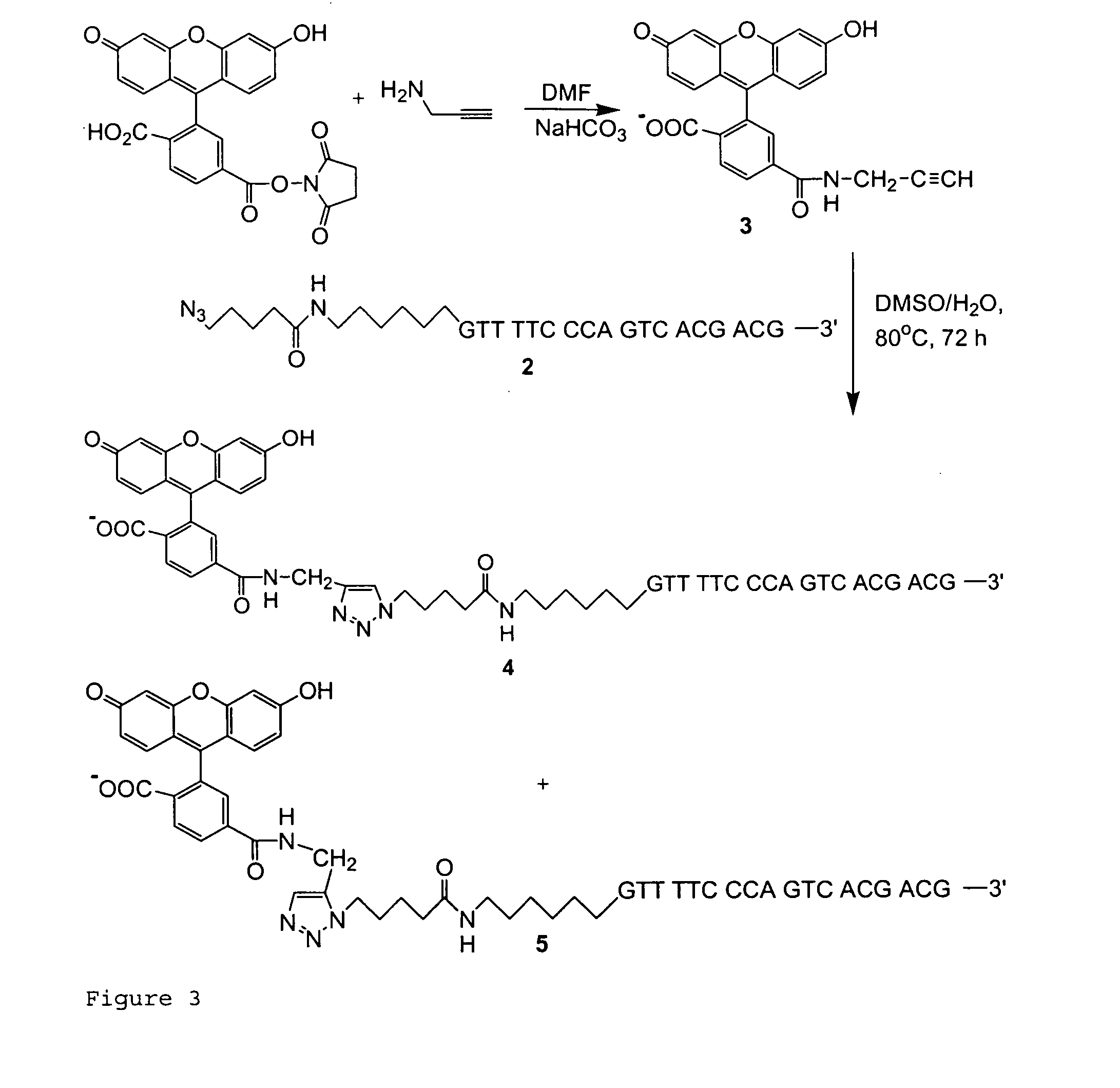Biomolecular coupling methods using 1,3-dipolar cycloaddition chemistry
a cycloaddition chemistry and biomolecular technology, applied in the field of biomolecular coupling methods using 1, 3dipolar cycloaddition chemistry, can solve the problem of inability to use direct phosphoramidite methods
- Summary
- Abstract
- Description
- Claims
- Application Information
AI Technical Summary
Benefits of technology
Problems solved by technology
Method used
Image
Examples
example 1
[0061]We explored the use of the “click chemistry” 1,3-dipolar cycloaddition reaction to couple a fluorophore to DNA. We show the synthesis of fluorescent single-stranded DNA (ssDNA) using the “click chemistry”, and the application of the fluorescent ssDNA as a primer in the Sanger dideoxy chain termination reaction (17) to produce DNA sequencing fragments.
[0062]Click chemistry 1,3-dipolar cycloaddition between alkynyl 6-carboxyfluorescein (FAM) and azido-labeled single-stranded (ss) DNA was carried out under aqueous conditions to produce FAM-labeled ssDNA in quantitative yield. The FAM-labeled ssDNA was successfully used to produce DNA sequencing products with singe base resolution in a capillary electrophoresis DNA sequencer with laser-induced fluorescence detection.
[0063]Initially, we synthesized an oligonucleotide labeled by an azido group at the 5′ end as shown in FIG. 1. 5-Azidovaleric acid was synthesized according to the literature (18) and activated as N-succinimidyl ester ...
example 2
[0067]Peptides can be similarly bonded to other biomolecules or solid surfaces. FIG. 6 shows the immobilization of a polypeptide on a solid surface by 1,3-dipolar cycloaddition reaction. The polypeptide is labeled with an azido group at the carboxyl-terminal residue, while the solid surface is modified by a heterobifunctional linker which produces a substituted alkynyl group at the end. After the 1,3-dipolar cycloadditon between the azido and the alkynyl group, the polypeptide is covalently attached to the surface via a stable 1,2,3-triazole linkage.
[0068]The positions of the azido and the alkynyl functional groups are easily interchangeable. FIG. 7 shows the scheme for the immobilization of a polypeptide on a solid surface by 1,3-dipolar cycloaddition reaction. The polypeptide is labeled with a substituted alkynyl group at the carboxyl-terminal residue, while the solid surface is modified by a heterobifunctional linker which produces an azido group at the end. After the 1,3-dipolar...
example 3
[0070]Sugars can be similarly bonded to other biomolecules or solid surfaces. FIG. 8 shows a scheme for the immobilization of a polysaccharide on a solid surface by 1,3-dipolar cycloaddition reaction. The polysaccharide is labeled with an azido group at the terminal sugar ring, while the solid surface is modified by a heterobifunctional linker which produces a substituted alkynyl group at the end. After the 1,3-dipolar cycloaddition between the azido and the alkynyl group, the polysaccharide is covalently attached to the surface via a stable 1,2,3-triazole linkage. The positions of the azido and the alkynyl functional groups are interchangeable as similarly shown in FIGS. 6 and 7.
[0071]The 1,3-dipolar cycloadditon reaction is controlled either thermodynamically at high temperature, or catalytically at room temperature with cucurbituril (21). In the absence of the catalyst the reaction is carried about within the temperature range 50° C. to 150° C., and more usually at between 70° C....
PUM
| Property | Measurement | Unit |
|---|---|---|
| temperature | aaaaa | aaaaa |
| temperature | aaaaa | aaaaa |
| temperature | aaaaa | aaaaa |
Abstract
Description
Claims
Application Information
 Login to View More
Login to View More - R&D
- Intellectual Property
- Life Sciences
- Materials
- Tech Scout
- Unparalleled Data Quality
- Higher Quality Content
- 60% Fewer Hallucinations
Browse by: Latest US Patents, China's latest patents, Technical Efficacy Thesaurus, Application Domain, Technology Topic, Popular Technical Reports.
© 2025 PatSnap. All rights reserved.Legal|Privacy policy|Modern Slavery Act Transparency Statement|Sitemap|About US| Contact US: help@patsnap.com



